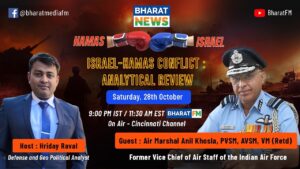(In random order)
Speculation: It is a failure of Israeli intelligence.
# Have they intentionally allowed it to happen?
-
-
- To gain legitimacy to crush HAMAS.
-
-
- Reunite Israelis, as fault lines had started appearing in Israel (Since January 2023, large-scale protests have been taking place across Israel in response to the government’s push for a wide-ranging judicial overhaul).
# Doesn’t seem to be true as the human cost is too high.
News: A barrage of rockets (more than 2,000 rockets) slammed into southern and central Israel.
# All operations start with LR Vectors to create disruption, destruction, and chaos, followed by attack of surface forces.
News: Infiltration initially was through tunnels, powered hang gliders, followed by a land route after the demolition of the fence. Even infiltration was attempted from the sea route.
# These methods would be picked up even by terrorist outfits for sub-con activities.
# Tunnels and drones are already being used by terror groups on the India-Pakistan border.
News: Dozens of fighter jets and other aircraft of the IDF targeted 17 military facilities and four operational headquarters of the Hamas terrorist organisation throughout the Gaza Strip.
# Fighter aircraft strikes are still a preferred option in non-contested airspace with no AD weapons.
# Drawing lessons from the Ukraine war, The IDF operations, and the HAMAS actions would take a different turn If countries sympathetic to Palestinians, armed them with shoulder-fired AD weapons.
View: Israeli Retaliation will be fierce and ruthless.
# It will cause high levels of casualties and collateral damage. The common man suffers in this cycle of hate.
# The chance of peace coming to the region will diminish further.
Speculation: Hamas must be banking on support (financial, military and diplomatic) from the Islamic states (primarily Iran, Turkey, Saudi Arabia, other Gulf States, and Egypt).
# Hamas does not have the military capability to take on IDF on its own.
# The conflict could spread in some or the other form to other states.
# On one hand the conflict is between the East and the West (eg Ukraine) and on the other hand, on religious divide (Islam vs rest).
# China has a reason to rejoice in either case.
Observation: The Hamas attack commenced on the day of the Sabbath.
# Military history is replete with wars commencing on dates when the enemy is likely to be off guard.
# In hostile and tense circumstances, the alertness level needs to be increased on such dates and occasions.
Speculation: What would be the response of Arab countries?
# It would be interesting to wait and watch in view of the fact that some of them have improved their relations with Israel recently.
Thought: How will it affect the Ukraine war?
# US attention will get divided.
Thinking Point: Impact on India and appropriate response.
# Another tightrope walk for India to not join any camp.
# Military supplies from Israel and cooperation would slow down.
# Take off of the India-Middle East-Europe Economic Corridor (IMEE-EC) would get delayed if not derailed.
Comparison: Whose narrative has greater acceptance and credibility?
# Israel is losing credibility due to recent actions leading up to this stage.
# Hamas is losing credibility due to the way they are killing and treating Israeli citizens.
View: This was bound to happen as the IDF was killing protesting Palestinian youth over the last few months. Palestinians reached their limits of forbearance.
# It is quite possible, with Palestinians surrounded and boxed in the Gaza Strip and West Bank, with no freedom, no control over basic necessities like food, water, and electricity, and constant harassment and encroachment.
# Although not advocated, Israel could learn from China the art of keeping the pot boiling, maintaining below a certain threshold, and making gradual gains.
Lesson: Role of media is important for influencing opinions.
Coming up: Detailed Analysis.
Suggestions and value additions are most welcome
For regular updates, please register here:
Subscribe
References and credits
To all the online sites and channels.
Disclaimer:
Information and data included in the blog are for educational & non-commercial purposes only and have been carefully adapted, excerpted, or edited from sources deemed reliable and accurate. All copyrighted material belongs to respective owners and is provided only for purposes of wider dissemination.


